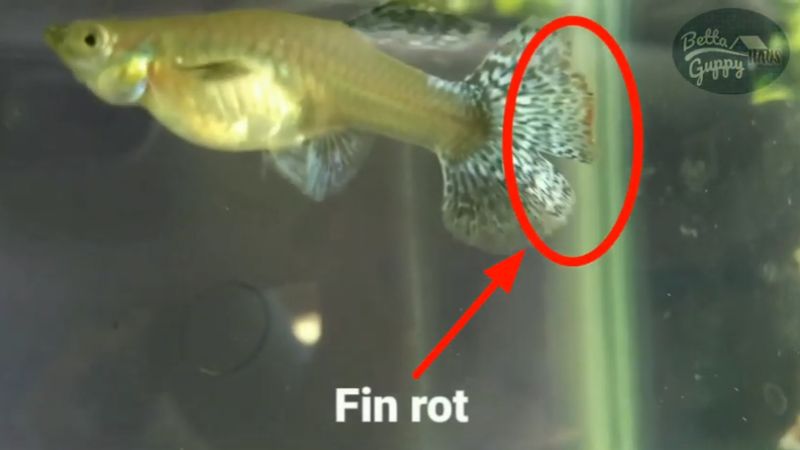Poor water quality, overpopulation, and stress are a few of the causes of guppy fin rot, a frequent ailment that affects many guppy fish. If neglected, this ailment can result in the fins being frayed, ragged, and discolored, as well as other health issues. To assist you in maintaining the health and happiness of your guppy fish, we will examine the causes, signs, and possible treatments for guppy fin rot in this post.
What Is Guppy Fin Rot?
Infection with bacteria or fungi is what causes guppy fin rot. This infection is brought on by the bacteria Pseudomonas fluorescens. It can only infest a fish’s body under specific circumstances but may be found in most aquariums. The fins of guppies with bacterial infections are ragged and irregular.
Keeping guppies in your tank might lead to the typical occurrence of guppy fin rot. Thankfully, it can be treated if caught early, but any delays in care might be fatal. The cause is unknown. However, it may be caused by bacteria or possibly a specific type of tank fungus.
It’s important to spot the signs in your aquatic pets as soon as they emerge. Learn how to recognize fin rot symptoms in this article, as well as how to cure and avoid the disease.
On the other hand, fin rot caused by a fungal infection shows up more uniformly with white dots on the fins. All fins, including the pectoral, dorsal, anal, and pelvic fins, are affected by both illnesses. During treatment, you should identify whether your guppies have fungal or bacterial fin rot.
What Are Symptoms Of Guppy Fin Rot?
Knowing the symptoms helps a lot. Even though each fish is different, some universal fin rot symptoms can be used as a warning sign, such as tiny tears in the fin, nibbling marks on the fin, or missing scales. Fin rot can also be identified by the loss of color or transparency of the fins as well as by the reddening of the fin margins and the gradual shortening of the fins. Often red or pink spots with a white, opaque growth are produced by bacteria developing from the base of the fin. Sometimes the bacteria will eat away at the fins in sporadic locations, leaving the fins with holes in various places. You might even observe that your fish is being lethargic.
Distinguish guppy fin rot and nipping
Nipping and guppy fin rot are two prevalent disorders that can harm guppy fish fins. However, they each have different causes and signs. Nipping is guppy fish will bite at each other’s fins, damaging and fraying them. This behavior is frequently the result of hostility or territorial disputes and is most frequently observed in male guppies. That might also happen if the tank is overloaded or too small. Providing a lot of hiding spots and lowering aggression with the right tank setup and tank mates are two treatment possibilities.
While both can harm guppy fish’s fins, various techniques must be taken for therapy.
How many types of guppy fin rot?
Mild fin rot, major fin rot, and severe fin rot are the three stages of fin rot.
- Mild fin rot: Fin tips start to mutate in color or get darker. The fins might be brown, gray, or white in hue. Fin edges have some little wear. Fin tips may appear swollen and reddened. There could be irritation visible on the fins. The edges of the fins exhibit decay.
- Major fin rot: The majority of fish caretakers overlook moderate fin rot. When this occurs, the illness intensifies into severe fin rot. Start therapy right away if your guppies are in this stage or risk further decreased immunity that will lead to additional ailments. More of the fins decay away than remain. Fins’ larger portions have a darker or discolored appearance. If your guppy has a fungus infection, the fins will have a white fuzz. The fins could begin to perish fully. The fins will detach in pieces.
- Severe fin rot: As you can see, leaving fin rot untreated in its initial two stages leads to severe fin rot. At this point, the virus typically worsens, making it nearly impossible to preserve your other fish. Body rot is another name for severe fin rot. The body of your guppy begins to deteriorate. Fins on guppies have completely degenerated or been consumed. The area where the fins were will have white fuzz if there is a fungal fin rot infection—a decrease in appetite. Guppies are struggling to breathe, straining for air.
What Causes Guppy Fin Rot?
Knowing about what can cause guppy fin rot can help you reduce the ability to catch disease for your fish. Fin rot is caused by many reasons, such as stress, inadequate water conditions the fish is being exposed to, the diet it is on, injuries, and even being exposed to other fish which may be sick. Guppy fin rot is a widespread disease among aquarium fish.
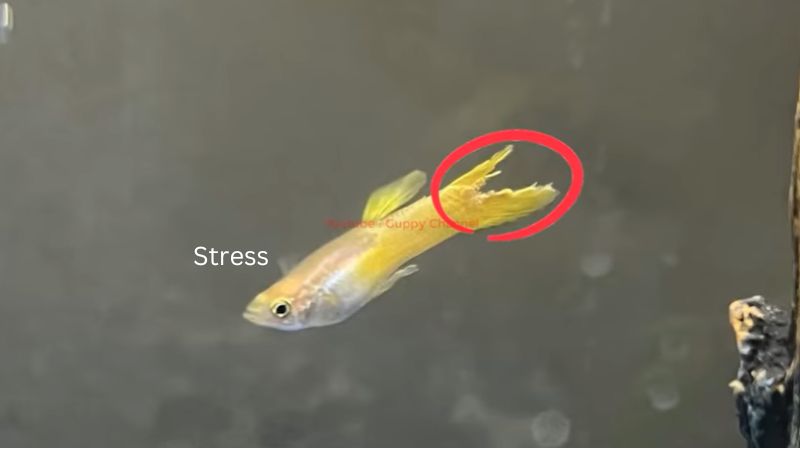
Stress
The most common cause of sickness in aquatic organisms is stress. If you’re curious how stress relates to Fin Rot, experts define stress in fish as a condition when the animal is unable to sustain a typical physiological state. In other words, because of outside influences, the fish’s body doesn’t operate as it should.
The immune system of guppies is weakened by ongoing stress. The disruption of the immune system is one of the main and most damaging impacts of stress in guppies. Also, once your finned friend’s immune is compromised, it becomes an easy target for a variety of bacteria and other organisms.
Stress may be brought on by bad water quality, combative tank mates, or changing pH and temperature levels. Guppy fish can show signs of stress by becoming pale or discolored, losing interest in feeding, sitting or swimming continually at the bottom of the tank, gasping for air while rising to the surface, losing weight (especially in female guppies), and having enlarged or cloudy-looking eyes.
Low quality of water conditions
In order to grow, guppies need tropical environments; they are native to South America. One of the most frequent causes of fin rot in guppy fish is poor water quality.
Water fluctuations might firstly lead to stress and have an effect on health. Second, it might encourage an unexpected rise of germs that harms your fish. Guppies require water with a steady pH of 7.6 and temperatures between 73 and 82 degrees Fahrenheit. Moreover, a Guppy tank’s ammonia and nitrite concentrations should never go above 0 ppm.
It is crucial for fish parents to have equipment installed in their aquariums to monitor and maintain water quality, such as water thermometers and filters. It’s also essential to frequently test the parameters with a high-quality water testing kit. It will negatively affect your fish’s health in a number of ways if water parameters are ignored for any reason. One of them is having an impact on your Guppy’s built-in defenses.
Feeding schedule
You wouldn’t believe it, but diet can also affect how fin rot develops in guppies. In the wild, guppies eat a wide range of things. Insects, insect larvae, and occasionally algae are among them. Fish nutrition is important for maintaining their health, which is why malnutrition can increase their susceptibility to diseases. To prevent malnutrition, fish keepers in captivity must recreate their diet to correspond to the species’ natural tendencies.
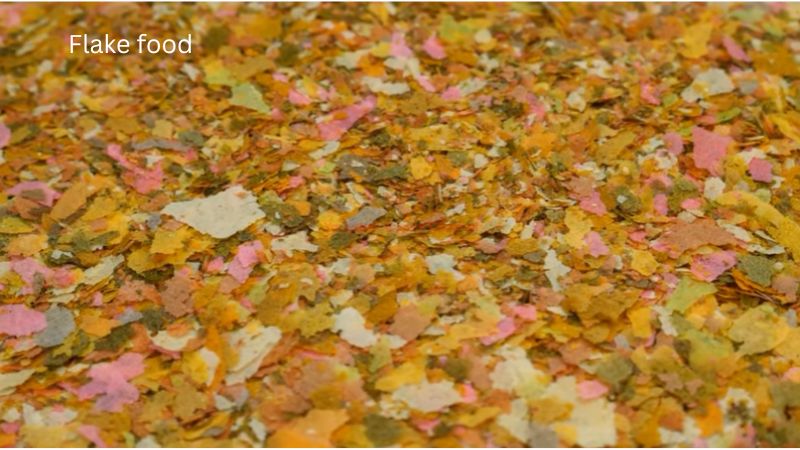
Beginner aquarists occasionally make the mistake of believing that commercial flake food is sufficient for their fish. Although commercial tropical fish food is made with a variety of vitamins and minerals, it is insufficient on its own.
For an ideal diet, experts advise including live (or frozen) foods and vegetation. Brine shrimp, daphnia, or bloodworms can provide your fish with an extra protein boost for growth. Conversely, a deficiency in vegetables or fiber might result in stomach or digestive issues, which can have a negative impact on your Guppy’s general health.
Beginner aquarists occasionally make the mistake of believing that commercial flake food is sufficient for their fish. Although commercial tropical fish food is made with a variety of vitamins and minerals, it is insufficient on its own.
Injured guppy fins
Guppies often damage and harm their long, thin, flowing fins on the rough edges of the fish tank. A case of guppy fin rot may also be caused by wounds, cuts, or scrapes on the skin. This is due to the possibility of the germs entering any opening on your finned friend’s body and wreaking havoc.
Guppies may potentially get illnesses if they are injured by aggressive bullies. Rainbowfish should not be kept company by large predatory species or fin nippers. If they stray too close to the territory of another species, aggressive or territorial fish may potentially end up hurting guppies.
Guppies are bottom-dwellers as well. Therefore, aquarists should be careful with the substrate they employ to prevent harm to the species. They are defenseless in this circumstance and will use every effort to prevent future injury.
Tank decoration is another uncommon cause of Guppy injury. In order to hide from larger fish, guppy fish in communal aquariums typically need a lot of hiding places. But if the décor is improper (has jagged or sharp edges), it can wind up scratching or slicing the skin of the fish.
Overcrowded tank
Guppies that are overcrowded are more likely to develop fin rot for three reasons. Your guppies won’t have as much room to move around, swim, hide, and play if your aquarium is overcrowded, to start with. This will cause these normally calm fish to become hostile and begin biting their fins. The nipped fins’ injuries make it simple for the guppies to contract infections that lead to fin rot.
Second, an overstocked fish tank will have a higher bioload, which will support the growth of hazardous germs. Your guppies’ defenses are weakened by these microorganisms.
Finally, your guppies will experience stress if their tank is overcrowded. Fish illnesses are more likely to develop in stressed fish. Exposure to sick fish is also a reason too.
How To Treat Guppy Fin Rot?
It is possible to treat guppy fin rot if you pay attention to water hygiene, use the proper water, and are careful with filtration, lighting, and warmth. The fish may be quarantined and given salt baths, methylene blue, stress coats, and antibiotics as treatments.
Be conscious of your hygiene
Every week, you must perform partial water changes besides cleaning your tank. You should also give the aquarium a thorough cleaning once every two months. Cleaning the inside of the tank’s walls and all of the embellishments is necessary. Perform small water changes in the main aquarium, ensure the filtration system is operating properly, and check the water’s chemistry.
In order to ensure that the fish are acclimated to their new surroundings, you must also use water from the main tank in the quarantine tank. You must also determine whether the fin rot is bacterial or fungal.
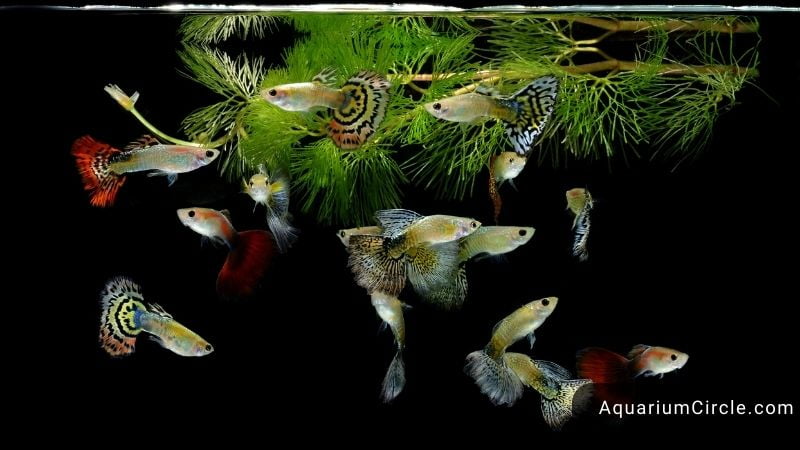
Right water
Because of their hardiness, guppies can live in brackish water with a pH of 7.0. Yet, chlorine is an issue for the majority of fish. To make water changes, fill a bucket with tap water and a water conditioner and leave it overnight if you must use tap water.
Fish become agitated when their environment undergoes frequent changes in water conditions, so it’s important to keep the pH level in mind. To treat severe fin rot, you will need to make sure the filtration system is up to par and that the aquarium’s atmosphere is optimum in terms of cleanliness.
Filters, lights, heaters
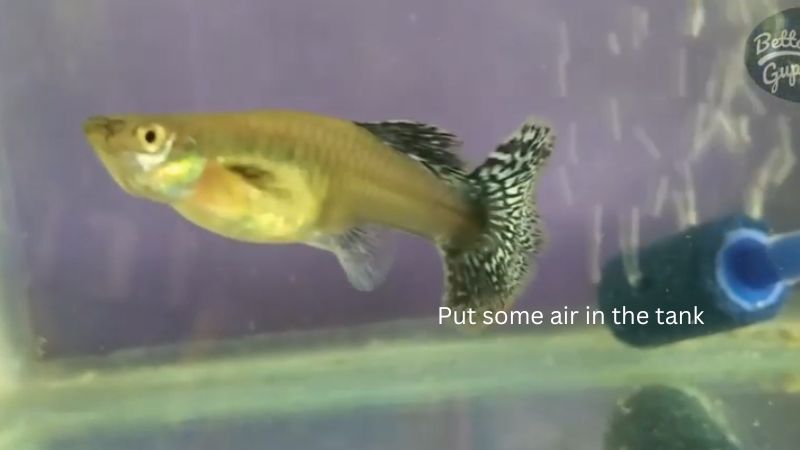
Your guppies must be treated by being placed in water that is kept at a constant 73 to 82 degrees Fahrenheit. So, you need a heater to maintain a constant temperature in order for your fish to recover from fin rot.
The filtering system must always be functional. Fish keepers advise using a sponge filter to maintain the aquarium clean and lessen the risk of injury to your guppies, which will gradually heal.
Separate tank
You should confine the infected fish in a hospital tank if your fish show severe signs of fin rot. When the symptoms of fin rot are identified early, treatment is rather simple. Yet, Fin Rot gets harder to treat in a communal tank as it worsens. Because the fish must adapt to the proper water conditions in order to mend more securely, the quarantine tank is crucial to the process of recovering from fin rot.
A lot of fish infections are frequently carried by guppies from pet stores. Before introducing new fish into the main fish tank, it is advisable that you quarantine them for at least 14 days after purchasing them from a pet store.
Use aquarium salt
Antibiotics are required for bacterial fin rot. But nonetheless, treatments with salt baths work well for superficial fungal fin rot. The fish’s resistance will be boosted in both the recovery tank and the main tank by adding tonic salt to each tank.
By raising the osmotic pressure in the tank, adding salts helps fish feel less stressed. For every gallon, use around a teaspoon of aquarium salt. You should seek advice from a veterinarian if you can clearly notice signs of Fin Rot and are unclear of how to treat your fish. The addition of livebearer salt to tanks, according to many seasoned fish keepers, will aid in the treatment of fungal or bacterial fin rot.
Methylene blue
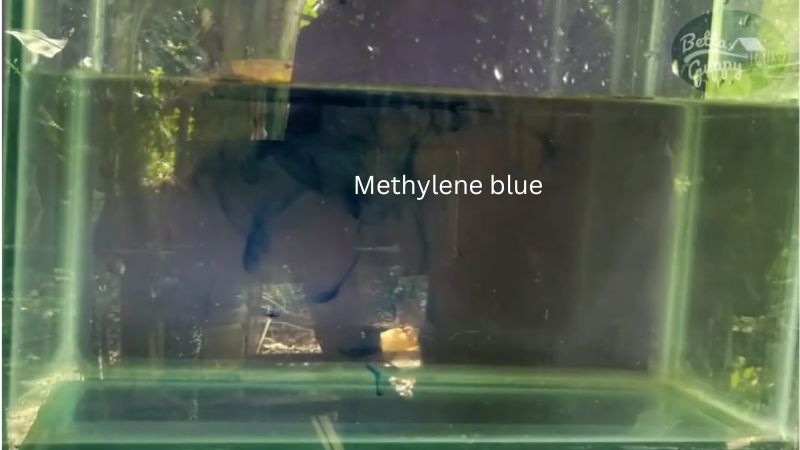
Furthermore, helpful in cases with severe fungal fin rot is the use of methylene blue. Fish lice and other parasite illnesses can be treated with methylthionine chloride. Moreover, it performs admirably against bacterial and fungal diseases.
Can guppy fin rot cure by itself?
Guppy fin rot cannot typically cure by itself. This condition is caused by bacterial infection, and if left untreated, it can lead to further health problems and even death. It’s important to address the underlying cause of the fin rot and to provide proper treatment to prevent the infection from spreading to other fish in the tank.
In some cases, if the fin rot is caught early and the underlying cause is addressed promptly, the fins may be able to grow back over time. However, it’s important to seek appropriate treatment to prevent further complications and ensure the health and well-being of your guppy fish.
Does guppy fin rot spread?
Yes, if untreated, guppy fin rot can be contagious from sick guppy fish in the aquarium. This illness is brought on by a bacterial infection, and other fish in the same environment are susceptible to contracting it very quickly. The bacteria that cause fin rot can get into the fish’s circulation, which can weaken their immune systems and cause additional health issues.
How To Prevent Guppy Fin Rot?
Learning how to prevent fin rot is better than finding how to treat fin rot.
- Establish ideal water conditions: If you maintain constant water temperatures, a neutral pH, and low ammonia, nitrate, and nitrite levels, your guppies will be free of fish diseases.
- Routine tank cleaning: Infection-causing germs are less prevalent in a clean tank. Keep in mind that the size and number of fish in the tank will have the biggest impact on your cleaning routine. More cleaning sessions are required for a small, overstocked tank than for a larger one.
- Make regular water changes: By often changing the water, you give your guppies a healthy habitat. The size and stocking of the tank will also affect how frequently the water has to be changed.
- Enough space: Maintaining the proper fish population will stop your aquarium fish from becoming aggressive and showing fin-nipping behavior. Also, there won’t be enough bioload to encourage the growth of dangerous microorganisms.
- Friendly tank mates: Guppies are calm community fish that should share a tank with other calm fish. Your guppies will experience stress and lose their resistance if they share an aquarium with aggressive fish.
Quality filters, quality food, and quarantine of new fish also are things that you can do for your guppy fish.
FAQs
Can Guppy live with angelfish?
Yes, guppies and angelfish can live together in the same tank, but there are a few things to bear in mind before doing so. There is a chance that because angelfish are bigger and more aggressive than guppies, they will mistake them for food and attack. Guppies and angelfish can coexist peacefully if the proper safeguards are taken, and the tank is acceptable for both species.
How long does fin rot take to cure?
The length of fin rot treatment can vary depending on the infection’s severity and how well it works. While more severe cases of fin rot may take up to a few weeks to significantly recover, moderate cases can start to show improvement within a few days with the right treatment and water conditions.
Will water change fix fin rot?
Water changes can help to prevent and treat fin rot, but they are not a guaranteed solution on their own. However, if the fin rot is already present, water changes alone may not be enough to cure the infection fully.
References:
- The Aquarium Wiki – https://www.theaquariumwiki.com/wiki/Poecilia_reticulata
- How to treat fin rot – https://www.wikihow.com/Treat-Fin-Rot

Annette M. Chaney is an experienced marine biologist with over 20 years of experience as an aquarist and fishkeeper. She started her first aquarium at a young age, filling it with frogs and goldfish obtained from the ten-cent pet store.
Annette grew up caring for and breeding African Cichlids, which led to a hobby in high school that doubled as a profitable means. Attending Reed College gave her time to solidify herself as an accomplished aquarium caretaker with an eye for sales. After that, from 2009 – 2013, she studied at Roger Williams University – one of the most prestigious universities for Aquaculture and Aquarium in USA. She is the founder of AquariumCircle since 2010.
